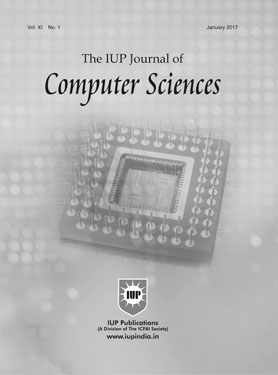
October'2022
Welcome to the IUP Journal of Computer Sciences
Focus
The second paper, "Deep Learning Techniques for Detecting Depression Signs from Text Messages: A Review", is by Divya Dewangan, Smita Selot and Sreejit Panicker. According to the World Health Organization (WHO), depression is a mental disorder and is deeply self-damaging. Depressed people exhibit different behaviors and actions. Intelligent technologies have now taken up the role of consultants. The study compared various Deep Learning models and hybrid Deep Learning techniques based on their accuracy of detection, and found that the transformer model and deep hybrid neural network model are highly superior and provide better accuracy than other algorithms.
The last paper, "Multilayer Perceptron Model for Macroeconomic Forecasting of Cryptocurrency Market in Nigeria", is by Eucharia Onyekwere, Francisca Nonyelum Ogwueleka and Martins Ekata Irhebhude. Financial time series data of the cryptocurrency market derived from the volume of Bitcoin transactions is complicated. In this study, Multilayer Perceptron (MLP) model with Backpropagation Algorithm (BPA) was designed to forecast the volatile time series data of the volume of Bitcoin transactions in Nigeria. Three different models-models 1, 2 and 3-were designed. Evaluation of the models was based on performance measures, and the results showed that the model with two hidden layers outperformed the other models. The paper also shows that virtual currency can be used as a revenue model if the right policies are implemented.
Consulting Editor
|
|
|||
| Article | Price (₹) | ||
| Improving the Efficiency of Resource Allocation in Time Shared Systems Using GMRRDQT Scheduling Algorithm |
100
|
||
| Deep Learning Techniques for Detecting Depression Signs from Text Messages: A Review |
100
|
||
| Multilayer Perceptron Model for Macroeconomic Forecasting of Cryptocurrency Market in Nigeria |
100
|
||
Improving the Efficiency of Resource Allocation in Time Shared Systems Using GMRRDQT Scheduling Algorithm
One of the most important tasks of the operating system is process scheduling. There are several algorithms for Central Processing Unit (CPU) scheduling; one of them is Round Robin (RR) which is used in time sharing systems. One problem in RR CPU scheduling is that if the time required for the running process is slightly more than the Quantum Time (QT) even by a fraction value, then process gets preempted and context switch occurs. Due to the unnecessary context transition, there is greater waiting time, turnaround time, and more overheads. Geometric Mean Round Robin with Dynamic Quantum Time (GMRRDQT) was developed to address the shortcomings of standard RR. In the developed algorithm, where a geometric mean approach was used for QT determination, if the process burst time is less than the QT, it runs to completion at the first circle, and if it is equal or greater than the QT, half of the task burst time should run to completion in the first circle, while the remaining task CPU burst time should run to completion in the second circle. The designed algorithm was evaluated against the standard RR and Hybrid RR Scheduling Mechanism for Process Management (HYRR) using analytic method. The findings show that the designed GMRRDQT algorithm produced better optimization in terms of minimum Average Waiting Time (AWT), Average Turnaround Time (ATT) and Number of Context Switches (NCS). The proposed algorithm, on the other hand, produced a higher Average Response Time (ART) compared to other algorithms that were considered for performance evaluation. It is recommended that further research should focus on optimizing the response time of the developed algorithm.
Deep Learning Techniques for Detecting Depression Signs from Text Messages: A Review
Depression is a mental disorder and is deeply self-damaging. A depressed person not only hurts himself but also causes more damage. The affected people show different behaviors and actions. As new technologies are introduced and the virtual environments are improving, intelligent technologies have replaced important people like therapists. Since the last decade, various state-of-the-art techniques have been proposed by researchers for the detection of depression moods in text messages. The paper reviews and analyzes various Deep Learning models and techniques that have already been utilized in earlier research and presents a comparison based on their accuracy of detection. The study observes that the transformer model and deep hybrid neural network model have arrived as the state-of-the-art and these are highly superior and provide much better accuracy compared to other algorithms.
Multilayer Perceptron Model for Macroeconomic Forecasting of Cryptocurrency Market in Nigeria
Financial time-series data derived from the volume of cryptocurrency transactions is complicated and challenging to predict due to the volatility and uncertainty of the digital market. In this paper, the Multilayer Perceptron (MLP) models with Backpropagation Algorithm (BPA) were designed to forecast the volatile time-series data of the volume of Bitcoin transactions in Nigeria. Three different models were designed, with one hidden layer, two hidden layers and three hidden layers. Evaluation of the models was based on performance measures, and the results show that model 2 with two hidden layers outperformed the other two models. Furthermore, the Autoregressive Integrated Moving Average (ARIMA) model was used as a benchmark for the MLP models. Compared to the ARIMA model, the MLP models had a percentage accuracy of 98.73%, 98.81% and 97.2% for model 1, model 2 and model 3, respectively. In contrast, the ARIMA model had a percentage accuracy of 53.87%.